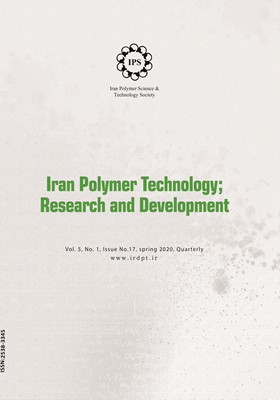مروری بر انواع روش های دارورسانی هدفمند
الموضوعات :آیدا چنگائی 1 , سید محمد رضا میلانی حسینی 2 , نصیبه سعیدزاده امیری 3
1 - دانشكده شيمي
2 - دانشكده شيمي
3 - دانشكده شيمي
الکلمات المفتاحية: سیستمهای دارورسانی حامل های نانو هدف گیری فعال نانو متخلخل ها,
ملخص المقالة :
یکی از مهمترین شاخه های علوم داروسازی، دارورسانی هدفمند می باشد که در سال های اخیر توجه پژوهشگران را جلب نموده است. نکته ای که محققین را به سمت دارورسانی هدفمند سوق می دهد، افزایش میزان اثر بخشی دارو و کاهش سمیت دارو به وسیله ی حامل های دارورسانی است. در این مقاله، انواع حامل های دارورسانی مورد بررسی قرار میگیرد که اهمیت دارورسانی و رهایش دارو را به خوبی نشان می دهند.
[1] سید محمد جواد حسینی زاده ، مروری بر مهمترین مکانیسمها و سیستمهای دارورسانی هدفمند، دانشگاه شهید بهشتی ایران ، فصلنامه علمی – پژوهشی بیولوژی کاربردی ، سال 1394
[2] خدیجه تلیکانی ، سنتز و تعیین مشخصات هیدروژلهای پایه کیتوسان در رهایش کنترل شده دارو ، دانشگاه گیلان ، سال 1394
[3] S.Maiti . K.Kumar Sen , Drug Delivery Concepts , DOI : 10.5772/6524
[4] Chong Li . J.Wang . Y.Wang , Recent Progress in Drug Delivery , Acta Pharmaceutica Sinica B , 2019
[5] K.Adibkia . M.Barzegar , A Review on the Porous Adsorbents in Drug Delivery Systems , Pharmaceutical Sciences , 2012
[6] M.Ngoepe . Y.E.Choonara , Integration of Biosensors and Drug Delivery Technologies for Early Detection and Chronic Management of Illness , DOI: 10.3390/s130607680
[7] H.Ghasemzadeh . H.Rashvand , Sodium Alginate/Talc-g-Poly Sodium Acrylate Nanocomposite for Delivery of Indomethacin , 2014
[8] Lin Y. S., Tsai C. P., Huang H. Y., Kuo C. T., Hung Y.,Huang D. M., Chen Y. C., Mou C. Y.Well-orderedmesoporous silica nanoparticles as cell markers, Journal of Chemistry Materials, 2005, 17: 4570-4573
[9] Theodorescu, D.; Wittke, S.; Ross, M.M.; Walden, M.; Conaway, M.; Mischak, H.; Frierson, H. Discovery and validation of new protein biomarkers for urothelial cancer: A prospective analysis. Lancet Oncol. 2006, 7, 230–240.
[10] Sijja, H.K.; East, M.P.; Mao, H.; Wang, Y.H.; Nie, S.; Yang, L. Development of multifunctional nanoparticles for targeted drug delivery invasive imaging of therapeutic effect. Curr. Drug Discov. Technol. 2009, 6, 43–51.
[11] Deo, S.P.; Moschou, E.A.; Peteu, S.F.; Bachas, L.G.; Daunert, S. Responsive drug delivery system. Anal. Chem. 2003, 75, 207–213.
[12] Pierige, F.; Rossi, S.S.; Magnani, M. Cell based drug delivery. Adv. Drug Deliv. Rev. 2008, 60, 286–295.
[13] Emerich, D.F.; Thanos, C.G. The pinpoint promise of nanoparticle based drug delivery and molecular diagnosis. Biomol. Eng 2006, 23, 171–184.
[14] Inzelt, G.; Pineri, M.; Scheltze, J.W.; Vorotyntsev, M.A. Electron and proton conducting polymers: Recent developments and prospects. Electrochim. Acta 2000, 45, 2403–2421.
[15] Vallet-Regí M., Balasa F., Colillaa M., Manzano M. Bioceramics and pharmaceuticals: A remarkable synergy, Solid State Sciences, 2007, 9: 768-776.
[16] Soppimath, K.S.; Aminabhavi, T.M.; Kulkarni, A.R.; Rudzinski, W.E. Biodegradable polymeric nanoparticles as drug delivery devices. J. Controlled Release 2001, 70, 1–20.
[17] Bianco, A.; Kostarelos, K.; Partidos, C.D.; Prato. M. Biomedical applciations of functionalized carbon nanotubes. Chem. Commun. 2005, 7, 571–577.
[18] Denkbas, E.B.; Odabasi, M. Chitosan microspheres and sponges: Preparation and characterization. J. Appl. Polym. Sci. 2000, 76, 1637–1643.
[19] Malam, Y.; Loizidou, M.; Seifalian, M. Liposome and nanoparticles: Nanosized vehicles for drug delivery in cancer. Trends Pharmacol. Sci. 2009, 30, 592–599.
[20] Millán, G.C.; Marinero, S.M.L.; Castaňeda, Z.A.; Lanao, J.M. Drug, enzyme and peptide delivery using erythrocytes as carriers. J. Controlled Release 2004, 95, 27–49.
[21] De, S.K.; Aluru, N.R.; Johnson, B.; Crone, W.C.; Beebe, D.J.; Moore, J. Equilibrium swelling and kinetics of pH responsive hydrogels: Models, experiments and simulations. J. Microelectromech. Syst. 2002, 11, 544–555.
[22] Jeong, B.; Gutowska, A. Lessons from nature: Stimuli-responsive polymers and their biomedical applications. Trends Biotechnol. 2002, 20, 305–311.
[23] Prasad, K.; Prathish, K.P.; Gladis, J.M.; Naidu, G.R.K.; Rao, T.P. Molecularly imprinted polymer (biomimetic) based potentiometric sensor for atrazine. Sens. Actuators B Chem. 2007, 123, 65–70.
[24] Miyata, T.; Asami, N.; Uragami, T. A reversibly antigen-responsive hydrogel. Nature 1999, 399, 766–769.
[25] Boeckle, S.; Wagner, E. Optimizing target gene delivery: Chemical modification of viral vectors and synthesis of artificial vector systems. AAPS J. 2006, 8, 731–742.
[26] Kudela, P.; Koller, V.J.; Lubitz. Bacterial ghost (BGs)-advanced antigen and drug delivery system. Vaccine 2010, 28, 5760–5767.
[27] Svenson, S.; Tomalia, D.A. Dendrimers in biomedical applications-reflections on the field. Adv. Drug Deliv. Rev. 2005, 57, 2106–2129.
[28] Rossi, L.; Serafini, L.; Pierigé, F.; Antonelli, A.; Cerasi, A.; Fraternale, A.; Chiarantini, L.; Magnani, M. Erythrocyte-based drug delivery. Expert Opin. Drug Deliv. 2005, 2, 311–322.
[29] Magnani, M.; Giovine, M.; Fraternale, A.; Damonte, G.; Rossi, L.; Scarfì, S.; Benatti, U.; DeFlora, A. Red blood cells as a delivery system for AZT. Drug Deliv. 1995, 2, 57–61.
[30] Wang S. Ordered mesoporous materials for drug delivery, Microporous and Mesoporous Materials, 2009, 117 : 1-9.


